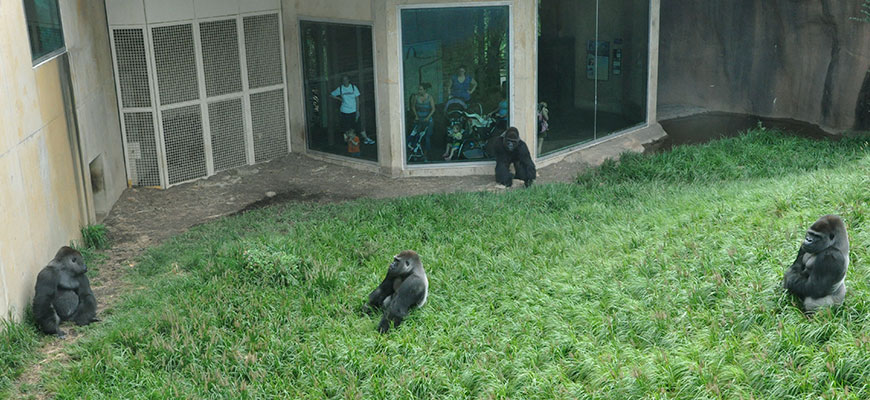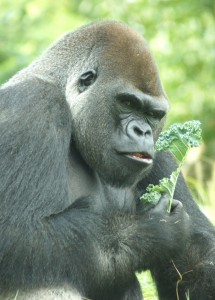by Jennifer Kemnitz
Our award-winning Gorilla Forest continues to break new ground as a research center and sanctuary for the ongoing improvement of gorilla care and conservation.
Opened in 2002, Gorilla Forest was designed so that the Louisville Zoo could house up to four gorilla groups, each with access to indoor day rooms and outdoor open-air fields. The groups rotate through the exhibit on a daily basis to provide a variety of enrichment opportunities similar to those they might experience in the wild, such as foraging for food in new areas and observing other gorillas from different vantage points.
Currently there are three gorilla groups that call Gorilla Forest home — a family group with one silverback and three females, a bachelor troop with four males, and one group affectionately referred to by keepers as “the old ladies,” Helen, who at 56 is one of the oldest gorillas in captivity, and Demba.
All of the gorillas at the Louisville Zoo are Western lowland gorillas, a species classified critically endangered by the International Union for Conservation of Nature (I.U.C.N.). It’s estimated that the gorilla population in the wild has declined by more than 60% over the last 20 to 25 years. Chief threats are the bush meat trade—the commercial hunting of gorillas and other species for food and souvenirs—and industrialization of the gorillas’ native habitats.
“In many of the areas where gorillas once lived,” says Jill Katka, assistant curator of Gorilla Forest, “there’s no forest left. Only remnants of the wild. People and gorillas encounter each other more often, and gorillas always lose the battle.”
As keepers and veterinary staff have learned more about the gorillas in their care, they’ve discovered another concern that may be particularly unique to great apes in captivity, who often live longer than they would in the wild. Heart disease is one of the leading causes of death, especially among males. This ever-growing body of knowledge about gorilla health has had a profound impact on the training practices at the Louisville Zoo.
“Gorillas are very susceptible to human illnesses,” explains Katka. All the keepers in Gorilla Forest must submit to a full health profile and be vaccinated regularly. The gorillas themselves must receive flu shots each year. Rather than inject them using a blow dart, which can cause undue stress on the animals, keepers train the gorillas to voluntarily submit to a hand injection.
“Gorillas are extremely intelligent. Our keepers work to build a relationship with each gorilla based on trust. It is critical to our ability to manage them.”
On one wall in the keeper area of Gorilla Forest, there is a large chart that lists all the gorillas and the behaviors each has either learned or is in the process of learning.
How do you train a 400 pound gorilla?
“With a lot of patience and a lot of love,” Katka says.

Gorilla Forest keepers left to right (front row): Shea Leffler, Michelle Wise, Kelly Bennett (Middle Row): Jill Katka, Alexis Williamson (Back Row): Richard Laird
Keepers in Gorilla Forest use a training method called operant conditioning. A gorilla is asked to perform a specific behavior—for example, to open its mouth so the keeper can look at its teeth. When the behavior is done correctly, the keeper blows a whistle to confirm, then gives the gorilla a grape or other food treat as reward. In a single training session, a gorilla might be asked to present its fingers, feet, ears, back, side, and stick out its tongue. Training for each gorilla is individualized and prioritized.
Another potentially life-saving behavior every gorilla learns is to present its chest, pressing it against the wire mesh that separates the gorilla and the keeper. The keeper then touches the gorilla’s chest with a training tool designed to look and feel like an ultrasound probe.
The Louisville Zoo is participating in the Great Ape Heart Project, based at Zoo Atlanta. The goal of the project is to create and maintain a centralized database to help analyze cardiac data, generate reports, and coordinate cardiac-related research activities. The project involves more than 30 institutions, including Louisville.
According to the Great Ape Heart Project, gorillas and other apes often don’t show any behavioral signs until a heart problem has progressed too far. “Early detection is imperative for treating heart disease in apes; and ultrasound exams have been a vital diagnostic tool in helping to determine early signs of the disease.”
Typically, ultrasounds were only performed during preventative health exams when apes were anesthetized. But some anesthesia can affect heart rates and produce unreliable results. To collect more accurate data, gorillas are now being trained to receive an “awake” ultrasound. This allows heart data to be collected more routinely, and places less stress on the animal.
The high levels of training and healthcare that are hallmarks of Gorilla Forest have truly made it a sanctuary for gorillas from around the country. The ten gorillas that now reside in Louisville have come from the Bronx, Cincinnati, Atlanta, St. Louis, Philadelphia, Dallas and Chicago.
The Species Survival Plan (SSP) that manages gorillas in AZA-accredited zoos may recommend transfers from one zoo to another for a variety of reasons, particularly for breeding purposes, but also to form a new bachelor troop when young males aren’t ready to join a family group, or to find a suitable location for a gorilla that has become isolated due to changing circumstances at its current location. The SSP takes into account the social and logistical needs of the gorillas; that is, whatever is in the individual gorilla’s best interest.
From ultrasound exams to rooftop fruit drops, the keepers and veterinary staff at the Louisville Zoo work tirelessly to provide a safe and enriching experience for each and every gorilla entrusted to them.
So the next time a gorilla sticks his tongue out at you, don’t take offense! He just wants you to make sure his tongue looks healthy.
Originally published in Trunkline Magazine, March. 2014.


